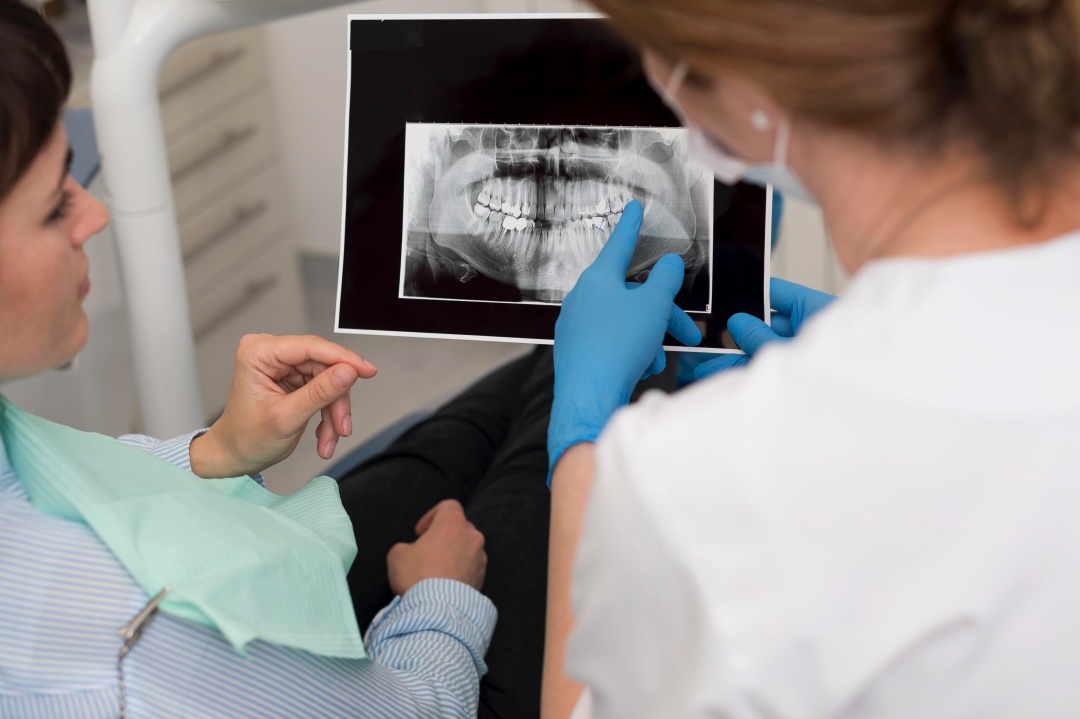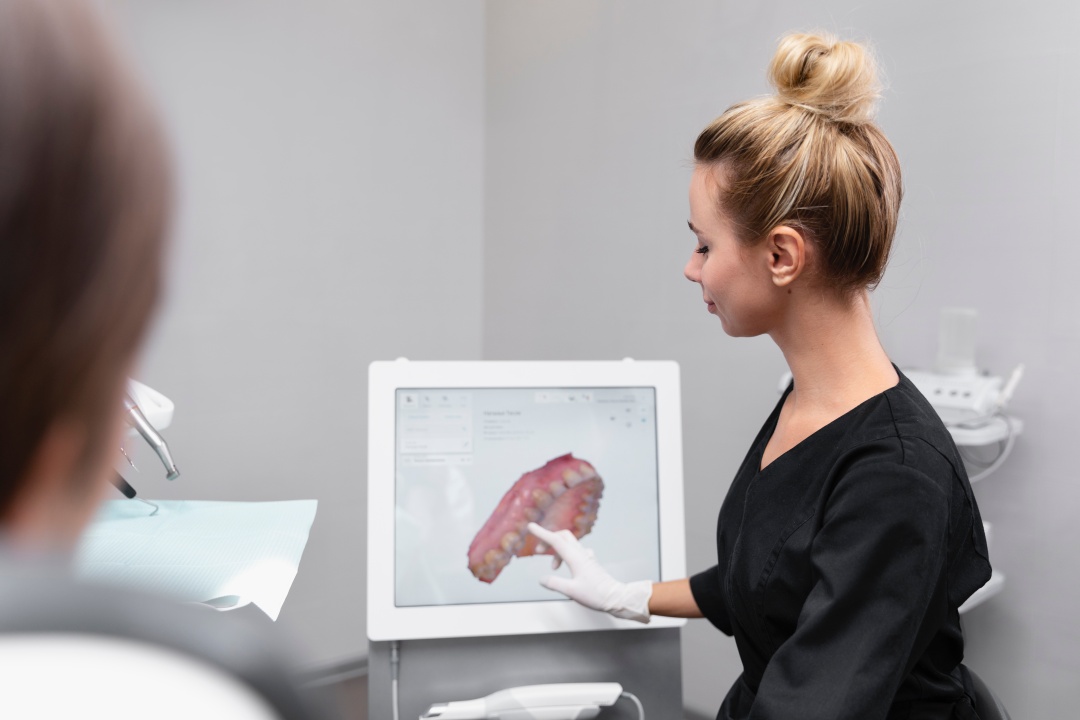Zirconium Crowns
All on 4 implants in Turkey
What is a zirconium dental crown?
Zirconium crown is a high-strength and biocompatible ceramic material used in dentistry. Zirconium crowns are a preferred treatment option today as they have superior features both aesthetically and functionally.

What are zirconium dental crowns made of?
Zirconium dental crowns are made of a ceramic material called zirconium dioxide. Zirconium dioxide is a compound derived from the naturally occurring mineral zirconium. Zirconium used in dentistry stands out with its high strength (high bending strength, high hardness), biocompatibility (compatible with body tissues, low risk of allergy), and aesthetic properties.
Properties of zirconium:
Zirconium dental crowns are a suitable option for patients with metal allergies due to their metal-free properties.The zirconium dioxide used to make zirconium crowns is usually partially stabilised with yttrium and enriched with aluminium. This process allows the material to gain its desired properties, such as high bending strength. Zirconium also has a naturally white colour, which allows it to be coloured to match the tooth colour.
Zirconium dental crown materials:
Zirconium dental crowns can be made using different types of zirconium.
Monolithic zirconium:
These are crowns made from a single piece of zirconium. They are generally preferred for back teeth.
Veneer zirconium:
These are crowns with a more aesthetic appearance obtained by porcelain coating on the zirconium substructure. They are especially preferred for front teeth.
Multilayer zirconium:
These are zirconium types with colour and transparency transitions from incisal to cervical as in natural teeth. In this way, more natural-looking restorations are obtained.
In which cases are zirconium dental crowns needed?
The need for zirconium dental crowns may arise due to damage to the teeth for various reasons or aesthetic concerns. We can summarise in which cases zirconium dental crowns are preferred as follows:
Large caries or damage to the tooth structure:
Large cavities or structural damage to the teeth can jeopardise the durability of the tooth. In such cases, zirconium crowns protect the tooth and restore its function.
After root canal treatment:
Teeth that have undergone root canal treatment can become more fragile. Zirconium crowns are often used to strengthen and protect teeth that have undergone root canal treatment.
Multiple or extensive proximal caries:
Caries in multiple or extensive neighbouring teeth can weaken the tooth structure. In this case, zirconium crowns support the restoration by ensuring the integrity of the teeth.
Hypoplastic teeth:
Teeth with impaired enamel development (hypoplasia) may be weaker and more sensitive than normal. Zirconium crowns protect these teeth and help them maintain their normal function.
Aesthetic concerns:
Zirconium crowns offer an aesthetic appearance very close to natural tooth colour. It is especially preferred in front teeth where aesthetic expectations are high. Unlike traditional metal-backed crowns, zirconium crowns do not reflect metal and do not cause dark discolouration of the gum line.
Patients with metal allergies:
Since zirconium is a metal-free, biocompatible material, it is an ideal alternative for patients with metal allergies.
Broken or cracked teeth:
Fractures or cracks in teeth can leave the tooth unprotected. Zirconium crowns cover the broken or cracked teeth, preventing the progression of damage and adding durability to the tooth.
Tooth wear:
Zirconium crowns can be used in the restoration of worn teeth due to reasons such as teeth grinding (bruxism). The lost height and form of worn teeth can be recreated with zirconium crowns.
Implant restorations:
Zirconium is often used to make implant abutments and implant crowns. This is particularly favoured in anterior areas where aesthetic results are important.

The main differences between zirconium dental crowns and conventional dental crowns are based on various factors such as materials used, aesthetic appearance, durability, application techniques, and cost. We can summarise these differences as follows:
Material:
Traditional crowns are usually made of porcelain over a metal (e.g., gold, nickel-chromium alloys) substrate. In some cases, they may also be made entirely of metal. Although metal substructures provide durability, they have some aesthetic disadvantages.
Zirconium dental crowns are made of zirconium dioxide ceramic. This material is known for its high durability, biocompatibility, and aesthetic properties. Zirconium is a metal-free ceramic and is often used partially stabilised with yttrium.
Aesthetic appearance:
Conventional dental crowns can create aesthetic problems, especially if the metal becomes visible at the gum line or at the edge of the crown. Although porcelain veneers try to reduce the opacity of the metal, it is not always possible to achieve a natural appearance, especially in light.
Zirconium dental crowns are a material with high translucency (light transmittance) and aesthetic properties close to natural tooth colour. In this way, it is easier to achieve a natural appearance, especially in the front teeth. Zirconium crowns eliminate the opaque appearance created by the metal substructure and do not cause problems such as greying of the gums. Options such as multi-layered zirconia can mimic the colour transitions and different levels of translucency as in natural teeth.
Durability and strength:
Traditional Crowns: Although crowns with a metal base are also durable, there is a risk of cracking or fracturing the porcelain coating. Especially in metal-ceramic crowns, problems such as chipping of the porcelain from the metal can be seen.
Zirconium crowns: Zirconium is a very durable material with very high bending strength and hardness. This makes the crown resistant to chewing forces and abrasion. Monolithic zirconium crowns are more durable than porcelain crowns.
Biocompatibility:
Conventional dental crowns: Some metal alloys (e.g., those containing nickel) can cause allergies or sensitisation reactions in some patients. This can be a particular problem for patients with metal allergies. Zirconium dental crowns: Zirconium is a 100% biocompatible material and interacts naturally with body tissues. It is very unlikely to cause allergy or sensitisation reactions.
Tooth preparation:
Zirconium crowns: Zirconium crowns usually require a uniform tooth cut of 1.0-1.5 mm. During tooth preparation, there should be no sharp corners or transitions, and all edges should be rounded. In some cases, more tooth tissue may need to be removed for zirconium crowns.
Traditional crowns: Metal-supported crowns also require tooth cutting, but the amount may be less in some cases than for zirconium crowns.
Production process:
Zirconium crowns are usually manufactured using CAD/CAM (Computer Aided Design/Computer Aided Manufacturing) technology. This technology allows the crown to be more precise and harmonised. Zirconium blocks are shaped in milling machines to produce the crown. The production of traditional crowns is mostly done by hand labour in the labouratory environment. The metal substructure is formed by pouring, and porcelain is applied manually.
Bonding:
Since zirconium has a chemically inert surface, bonding requires special care, and resin cements are used. These cements form a strong bond with the zirconium, allowing the crown to remain in the mouth for a long time.Crowns with metal substructure can be bonded with conventional cements, but it is recommended that they be bonded with resin cements.
Cost:
Traditional metal-supported crowns are generally more affordable than zirconium crowns.Zirconium crowns are generally more costly than metal-supported crowns. This is due to factors such as material cost, production technology, and labour.
Areas of use:
Zirconium crowns are widely used in both anterior and posterior teeth, single crown restorations, bridges, and implant prostheses. It is especially preferred when aesthetic expectations are high.Traditional crowns are used in a similar way but may be preferred when aesthetic expectations are lower or cost is a priority.
Repair and maintenance:
Traditional crowns can be repaired more easily in some cases, but repair or replacement of the porcelain veneer can still be challenging.
The application of zirconium crowns is a multi-stage process that involves the collaboration of the dentist and dental technician. This process includes the correct diagnosis, proper tooth preparation, precise impression taking, the laboratory phase and finally the bonding of the crown to the tooth.
When you come to our clinic, our dentist will check your oral and dental health. At this stage, the tooth or teeth that need crowns will be identified, existing restorations will be evaluated, and a treatment plan will be created. Our dentist will determine the suitability of the zirconia crown and the type of zirconia to be used (e.g., monolithic, multilayer), taking into account your expectations and aesthetic requirements.
Tooth preparation:
Our dentist prepares the tooth or teeth where the crown will be placed. In this process, about 1-1.5 mm of tooth tissue is removed from around the tooth. It is important to make a uniform cut around the tooth. The cutting of the tooth aims to ensure that the crown fits properly and provides an aesthetic appearance. Rounded lines are created, avoiding sharp corners and transitions. This improves the fit of the crown and reduces stress.
Preparation for the anterior teeth:
On the anterior teeth, a 1-1.5 mm cut is made on the incisal (cutting edge) area and surface, and a concave cut is made on the lingual surface (lingual side).
Preparation for the posterior teeth:
On the posterior teeth, 1.5-2 mm is cut from the occlusal (chewing surface) area and 1-1.5 mm from the axial (lateral) surfaces.
Taking impressions:
After tooth preparation is completed, an impression is taken from your mouth. This impression is used to obtain the model to be used in the laboratory to make the crown. Measurements can be taken using traditional impression-taking methods (with silicone impression materials) or digital scanners. Digital scanning methods allow more precise measurements to be taken.
Laboratory phase:
The impression or digital scan data is sent to the laboratory. In the laboratory, zirconium crowns are usually produced using CAD/CAM (computer-aided design/computer-aided manufacturing) technology.
CAD (computer-aided design):
A 3D model of the tooth is designed in a computer environment using specialised software. At this stage, the shape, size, and fit of the crown are carefully determined.
CAM (computer-aided manufacturing):
The designed crown is cut from zirconium blocks with special milling machines. The zirconia is usually processed into “green” blocks and then hardened by sintering at high temperatures of 1500-1550°C. This process gives the crown its final shape and durability.
Colouring:
After sintering, the crown can be tinted to match the natural tooth colour.
Porcelain Application (if necessary):
In some cases, porcelain veneers can be applied over the zirconium crown, especially on front teeth where aesthetic expectations are high. Porcelain gives the crown a more natural appearance.
Proofing and fit check:
The zirconium crown prepared in the laboratory is sent to our dentist. Our dentist places the crown in your mouth and checks its fit, edge adaptation, and occlusion (bite). If necessary, he makes minor corrections.
Bonding (cementation):
After the fit check, the zirconium crown is ready to be bonded to the tooth. MDP resin cements are preferred for zirconium crowns.These cements form a strong chemical bond to the zirconium surface, allowing the crown to remain in the mouth for a long time.The cement is applied to the tooth and inside the crown.The crown is placed on the tooth and gently pressed.Excess cement is removed. The cement hardens with light or by itself. The occlusion is checked again, and necessary corrections are made.
Final Check-ups and Care:
Regular dental check-ups are important after the application of zirconium crowns.
The advantages of zirconium crowns stem from both their aesthetic and functional properties. We can summarise the advantages of zirconium crowns as follows:
Superior aesthetic appearance:
Zirconium perfectly mimics the appearance of natural teeth. Since it does not contain metal, it transmits light like natural teeth and does not create dark discolouration in the gum line. In this way, it meets high aesthetic expectations, especially in the front teeth.
High strength and durability:
Zirconium has exceptional bending strength and hardness. Thanks to these properties, it is highly resistant to chewing forces and abrasion. This ensures the longevity of zirconium crowns.
Biocompatibility:
Zirconium is a 100% biocompatible material that interacts naturally with body tissues and is unlikely to cause allergic reactions. It is a safe alternative for patients with metal allergies.
Metal Free:
Unlike traditional metal-backed crowns, zirconium crowns are metal-free. This makes it an ideal option for patients with metal allergies, as well as positively affecting the aesthetic appearance. Since there is no metal reflection, it offers a more natural appearance.
Precision manufacturing:
Zirconium crowns are produced with CAD/CAM (Computer Aided Design/Computer Aided Manufacturing) technology. Thanks to this technology, crowns are designed and manufactured much more precisely. This ensures a perfect fit of the crown to the tooth and better retention.
Low plaque accumulation:
The smooth and polished surface of zirconium minimises plaque buildup. This helps maintain gum health and reduces gum irritation.
Colour stability:
Zirconium is colour stable and does not discolour or fade over time. This means that crowns retain their aesthetic appearance for a long time.
Various application areas:
Zirconia crowns have a wide range of applications, from single tooth restorations to bridges, implant abutments, and implant overdentures.
Minimal tooth abrasion:
In some cases, tooth preparation for zirconia crowns may require less tooth abrasion than for metal ceramic crowns.
Versatility:
Zirconium crowns can be adapted to different clinical situations and patient needs. With a choice of monolithic, veneered, or multilayer zirconia, different aesthetic and functional requirements can be met.
Oral health:
Because zirconium is a biocompatible material, it is compatible with oral tissues. It does not cause problems such as inflammation or irritation of the gums.
- Zirconium crowns are generally more costly than traditional metal-supported crowns. This can make zirconium crowns a less accessible option for some patients.
- In some cases, zirconia crowns may require the removal of more tooth tissue than metal-backed crowns.
- Zirconium is a naturally opaque material. Therefore, it can be difficult to achieve full colour matching with natural teeth, especially with monolithic zirconium crowns.
- When porcelain veneers are placed over the zirconium substructure (especially preferred for a more aesthetic appearance on the front teeth), there is a risk of cracking or fracture of the porcelain. This can occur especially in areas where chewing forces are high or in malocclusions. The porcelain crown may need to be repaired or replaced.
- When zirconia crowns are damaged, they can be more difficult to repair than conventional crowns. In particular, in cases of fractures or cracks, the crown may need to be completely replaced.
- The high hardness of zirconium can, in some cases, cause abrasion of the opposing teeth, which can be particularly noticeable in patients who have a habit of teeth grinding (bruxism).
- Unlike stainless steel crowns, zirconium crowns cannot be crimped. Therefore, the tooth needs to be precisely prepared so that the crown fits perfectly on the tooth.
- Zirconium has a chemically inert surface, making it difficult to bond with some adhesives.
- Gingival bleeding and inflammation may occur during zirconium crown preparation. This can cause problems, especially during bonding of the crown, and can adversely affect the bonding procedure.
- In some cases, zirconium crowns can be overcontoured, which can occur especially during the processing of zirconium in the laboratory and can cause irritation or discomfort to the gums.
- The lifespan of zirconium crowns can vary depending on various factors, but in general they are considered long-lasting restorations. The factors that affect the lifespan of zirconium crowns are as follows:
- Thanks to their high strength, zirconium crowns can retain their function for many years. The materials and technology used in the production of zirconium crowns also affect their lifespan.
- Good oral hygiene is essential for the longevity of crowns. Regular brushing, flossing, and regular dental check-ups maintain the health of the crowns and surrounding dental tissues. Poor oral hygiene can cause gum problems and infections around the crown, which can shorten its lifespan.
- The area of the mouth where the crown is located also affects its lifespan. Crowns on the back teeth may be at greater risk of wear because they are more exposed to chewing forces. In the front teeth, aesthetic expectations are more prominent, and crowns in these areas may need more careful maintenance.
- In general, zirconium crowns can be used for many years (10 years or more) without any problems, provided that good oral hygiene, correct dentist and technician practices, the use of appropriate materials and technology, and attention to the patient’s habits are observed.
- For the longevity of your zirconium crowns, it is important to follow your dentist’s recommendations, perform regular oral care, and keep regular check-ups to detect potential problems early.
-
The duration of aesthetic zirconium treatments can vary depending on several factors and usually involves several visits.
Initial examination and planning:
- This stage usually requires a visit to a dentist and takes about 30-60 minutes.
- Tooth preparation can take 1-2 hours, depending on the number and complexity of teeth.
- Measurement takes about 15–30 minutes. Digital scanning methods can be faster.
- The laboratory phase can take a few days to a week, depending on the lab’s workload and the complexity of the restoration.
- Placing the crown in the patient’s mouth and checking the fit, edge adaptation, and occlusion takes about 30-60 minutes. If necessary, minor corrections are made, and the patient can see the colour and shape of the crown at this stage.
- After the fit check, the zirconium crown is ready to be cemented to the tooth. The cementation process takes approximately 30-60 minutes.
- Once the treatment is complete, our dentist may ask for one or two more follow-up appointments in a few weeks. These appointments usually take 15–30 minutes.
- The total duration of the zirconium crown treatment can usually take several weeks. In simple cases, 2-3 weeks may be sufficient, whereas in more complex cases, this can take up to 4-6 weeks.
- Simple restorations, such as single tooth crowns, can be completed more quickly, while more extensive treatments, such as multiple crowns or bridges, can take longer.
- In some cases, laboratory processes can be accelerated, and zirconium crowns can be applied in a single day in some clinics.
- Additional treatments: If necessary, additional procedures such as root canal treatment or gum treatment can prolong the treatment process.
-
- Caring for zirconium teeth is similarly important to caring for natural teeth and should be done regularly to maintain oral health. Here are the things to consider for the care of zirconium teeth:
- Brush your teeth at least twice a day, morning and evening, using fluoride toothpaste. Brushing should cover all surfaces of the teeth (front, back, and chewing surfaces).
- Use dental floss or an interdental brush to remove plaque and food debris from between teeth. Floss should be applied carefully all the way below the gum line.
- In addition to brushing and flossing, using an antiseptic mouthwash promotes oral hygiene.
- Once you have your zirconium teeth, go for regular check-ups at intervals recommended by your dentist. At these checkups, the overall health of your teeth and gums will be assessed
- Get periodic professional dental cleanings by your dentist or dental hygienist. This removes plaque and tartar buildup from your teeth and protects your gum health.
- Sugary and acidic foods and drinks can cause tooth decay and gum problems. Limit the consumption of such foods or rinse your mouth with water after consuming them.
- Eat a balanced and healthy diet for your dental health. Take care to consume plenty of fruits, vegetables, and fibre-rich foods.
- Although zirconium teeth are durable, avoid biting down on extremely hard foods (ice, nuts, etc.). This prevents damage to the crowns or bridges.
- If you have a problem such as teeth grinding or clenching, you can use night aligners in consultation with your dentist. This will prolong the life of your zirconium teeth.
- Smoking and tobacco products negatively affect the health of teeth and gums. It can also cause changes in the color of zirconium restorations.
- Make sure that the zirconium crowns or bridges fit your teeth perfectly. If you feel any discrepancy, contact your dentist.
- Check the color and aesthetics of your zirconium teeth regularly. If you notice any changes, consult your dentist.
- If you think there is a problem with the adhesive (loosening, etc.), contact your dentist.
Frequently Asked Questions (FAQ)
Since local anaesthesia is used during zirconium crown application, the procedure is painless. Slight sensitivity after the procedure is normal.
You need to discuss this with our dentist and decide together.
The prices of zirconium dental crowns in Turkey vary depending on factors such as the region where the clinics are located, the quality of the material used, and the expertise of the dentist. Therefore, zirconium dental crown prices range from approximately 175 euros to 269 euros, and you can contact ViviMediile to find out the current prices.
The titanium implants are securely placed into the jawbone, where they naturally integrate and fuse with the bone during the healing phase.
As a stable and integrated part of the jaw, the new teeth can now be placed and fixed on the four implants in the form of a complete prosthesis on the same day. Your teeth can be loaded immediately and look so natural that there is no noticeable difference to real teeth.

